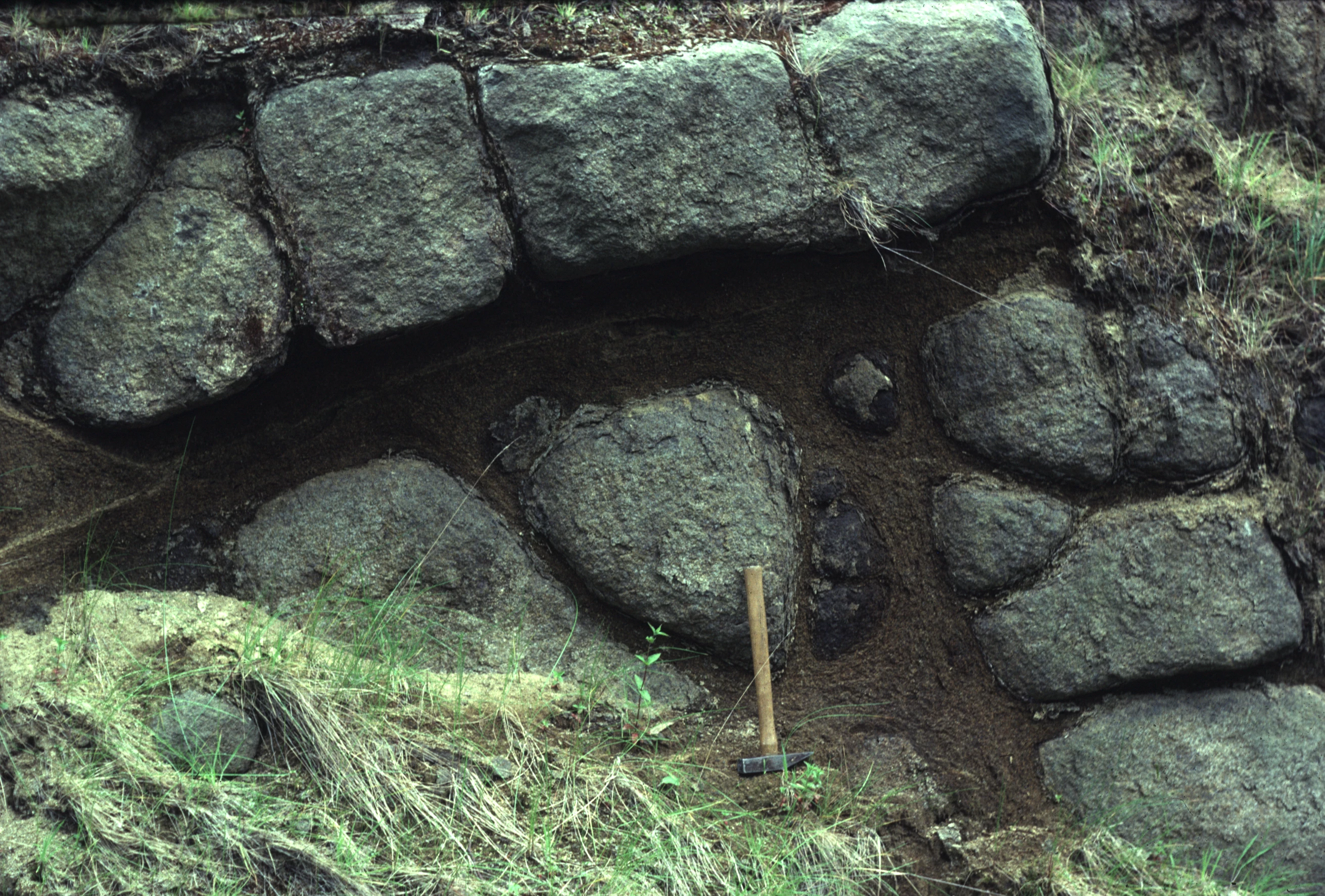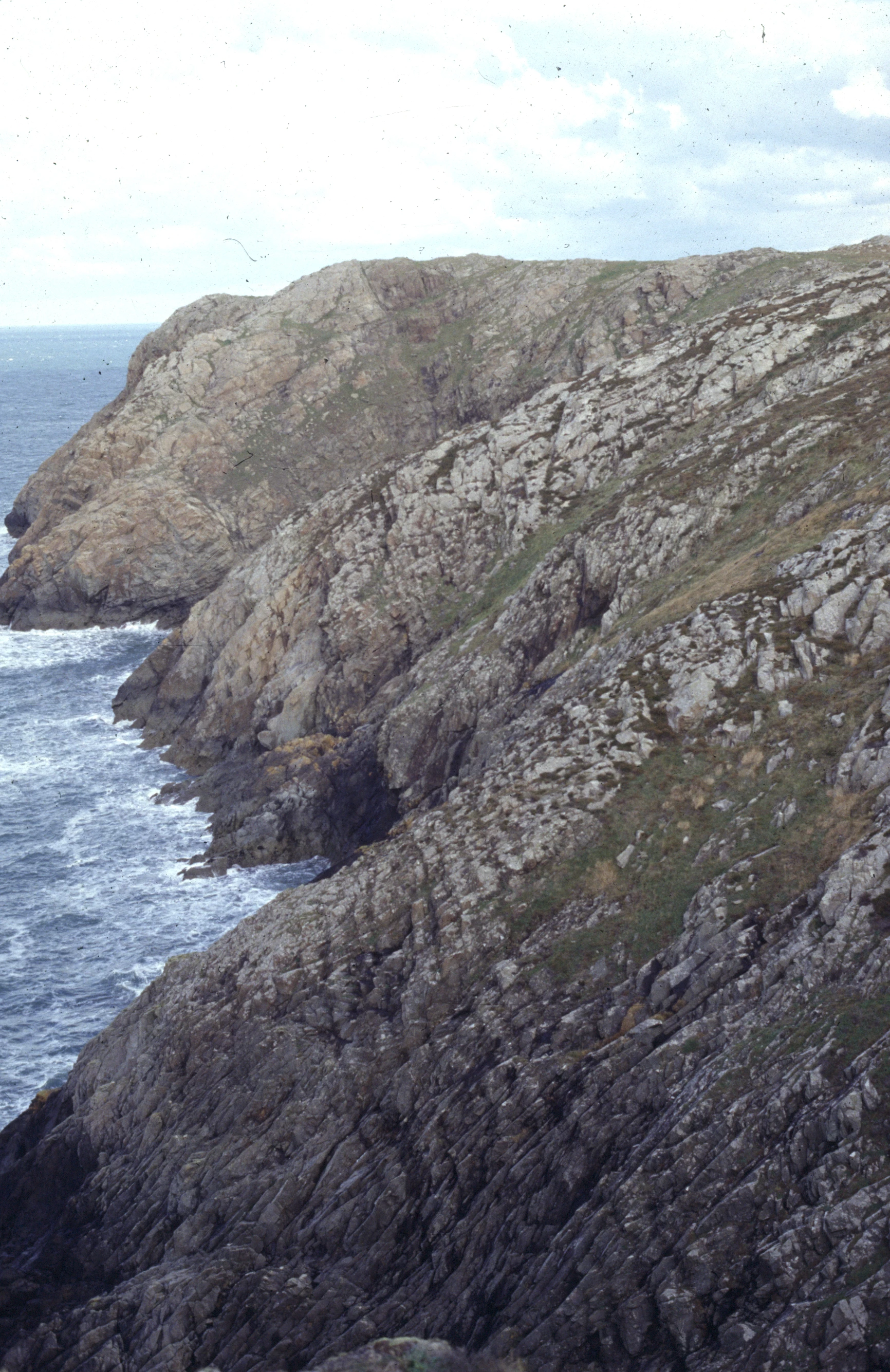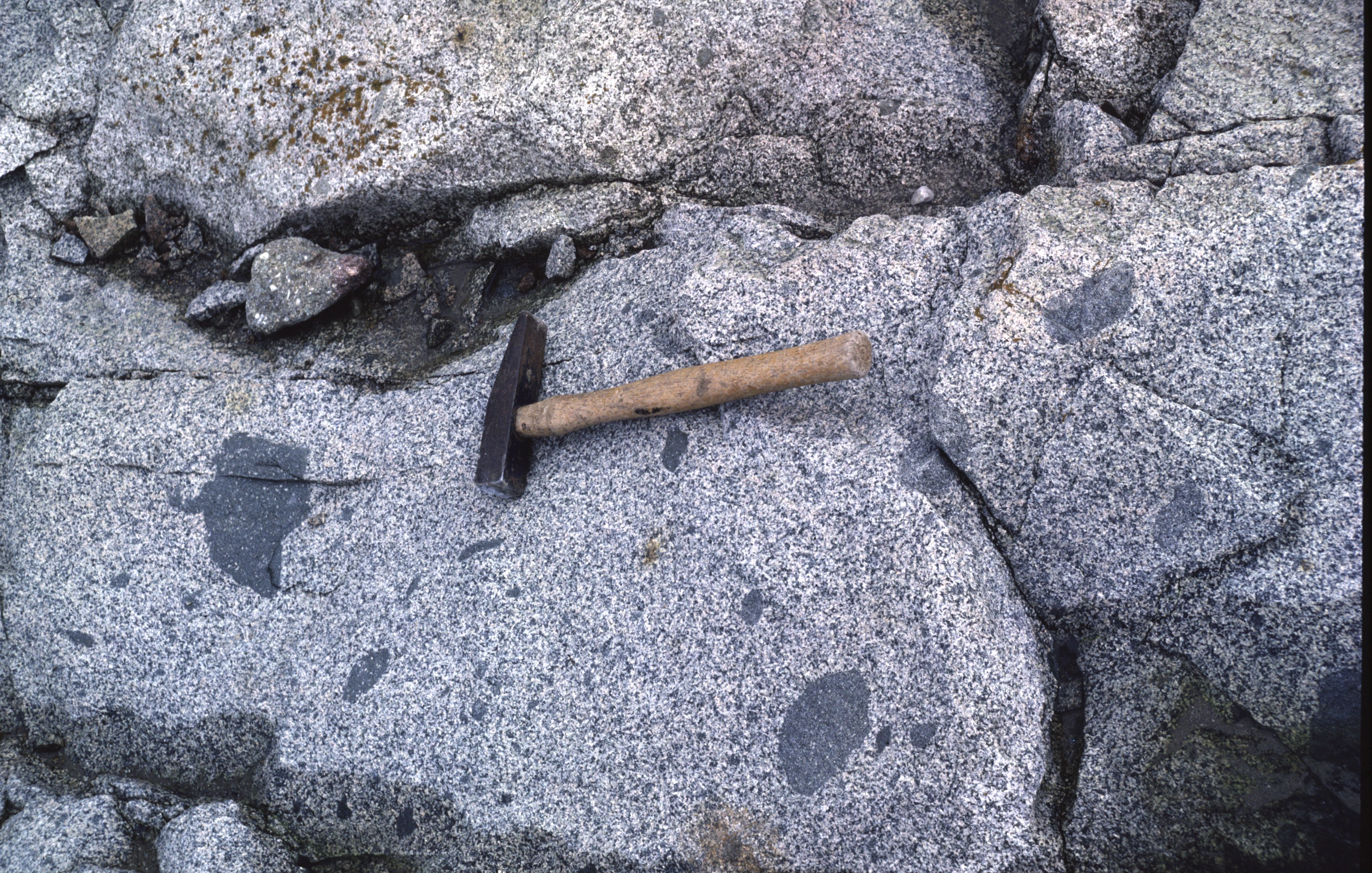Igneous Minerals
Igneous minerals form during the cooling and solidification of molten rock, or magma, produced at high temperatures (around 650 to 1200°C) beneath the Earth's surface. Which minerals crystallize from the magma is influenced by factors such as its chemical composition, the temperature of crystallization, and the rate of cooling.
Ackley Granite, Newfoundland showing large crystal size typical of granite. Photo © J.M. Horák.
Igneous rocks that form by a gradual cooling process tend to contain larger crystals whilst relatively fast cooling of magma results in much smaller crystals, as they do not have so much time to grow. Large masses of magma that do not reach the Earth’s surface but cool and crystallize at depth are know as plutons. When eventually exposed at the surface they are typically several kilometres across. It has been calculated that plutons take tens of thousands to millions of years to cool depending on their size and the depth at which they solidify. It has also been calculated that plutons containing large feldspar crystals, several centimetres across, these crystals may take tens to hundreds of thousands of years to grow.
Composition of Magma – (acid, intermediate, basic and ultrabasic)
Magma varies in chemical composition. For example the silica (SiO2) content of igneous rocks typically ranges from 75% to less than 45% (by weight) producing compositions from acid, through intermediate and basic, to ultrabasic. The various magma compositions result in contrasting mineralogies.
Photograph of a microscope slide (0.03 mm thick slice of rocks) of basalt from Anglesey, North Wales. This rock is fine-grained (crystals less than 0.5 mm) reflecting its rapid cooling after it intruded older rocks around 60 million years old. © National Museum of Wales.
Acid rocks contain relatively high quantities of sodium, aluminium and potassium and more than 65% silica. Rocks in this group are light in colour because they are dominated by the minerals quartz, potassium and sodium (alkali) feldspar, and plagioclase feldspar and they may also be described as felsic. Rocks types include granite, granodiorite and their volcanic equivalents rhyolite and dacite. Dacite and granodiorite may contain slightly more dark iron and magnesium-rich minerals such as biotite and amphibole than granite and rhyolite.
Spheroidal weathering pattern in a Tertiary dyke exposed near Bangor, Gwynedd. Photo R.E. Bevins, © National Museum of Wales.
Intermediate rocks are less silica-rich, containing 52-65% SiO2. They are composed of less than 10% quartz and one or two feldspar minerals (plagioclase and/or alkali feldspar). In Wales, rocks from this group include diorite, andesite, trachyte and lamprophyre.
Basic rocks are rich in calcium, iron, and magnesium but relatively poor in silica (SiO2 45-52%). This group includes fine-grained basalt and coarse grained gabbro . These rocks are also referred to as mafic as they have large content of minerals rich in iron and magnesium such as pyroxene, amphiboles and olivine .
Ultramafic rocks (also referred to as ultrabasic) are the most silica poor group and consist essentially of ferromagnesian minerals such as pyroxene, olivine, and spinel. Peridotite is an ultrabasic rock consisting of olivine, with or without pyroxene, whereas picrite, in addition to ferromagnesian minerals, may contain up to 10% feldspar. With an increase in feldspar, picrite composition grades into gabbro. Ultramafic rocks typically occur with basic rocks, and may contain appreciable amounts of chromium and platinum-group minerals.Igneous Rocks in Wales (1)
The igneous rocks of Wales range in age from Precambrian (650-540 million years) to Palaeogene (c. 65 million years). In general, the basic rocks display a wider range of mineralogy than those of acid composition.
Pillow lavas, probably around 600 million years old, from Llanddwyn Island, Anglesey. These formed where basic lava erupted, cooled rapidly and solidified underwater. Photo © J.M. Horák
Ordovician mafic rocks are particularly widespread in Wales, magmas that intruded to high levels in the crust formed sills and dykes, but it also erupted on land, and under the sea as lava flows. The largest sills, composed of gabbro, are exposed in the St. David’s area of Pembrokeshire (Roach, 1969; Bevins et al., 1994) and at Rhiw, on Pen Llŷn (Hawkins, 1970; Cattermole, 1976). Basic volcanic rocks are present as lava flows, or tuffs, but where the magma erupted underwater, spectacular piles of pillow lava were produced. Excellent examples of pillow lavas are seen in west Wales, on Strumble Head, in north Wales, on Cader Idris and on Pen Llŷn, and in south-west Anglesey.
The St David’s Head Intrusion, near St. David’s, Pembrokeshire is composed of a thick sequence of gabbro layers which show a range in their chemical composition. Photo R.E. Bevins, © National Museum of Wales.
Bodelias intrusion, Pen Ll?n, North Wales. This shows evidence of interaction between basic and acid magmas. The darker blobs of basic (basaltic) or intermediate (andesitic) magma that have intruded the granodiorite magma and cooled before they could mix. Photo © R.E. Bevins.
Acid volcanism played an important part in the early geological history of Wales. From around 600 million years ago, in the Late Precambrian, until Late Ordovician times (around 445 million years ago) explosive volcanicity produced large volumes of acid magma, now preserved as thick sequences of tuff. The famous landmark of Snowdon, is formed from such volcanic rocks. Although acid igneous rocks generally have simple mineralogies dominated by feldspar and quartz, in some instances more unusual compositions generate a more varied mineralogy. For instance the Mynydd Mawr intrusion in Snowdonia (Nockold, 1938) has a peralkaline composition, which is characterized by a high content of Na and K and relatively low Al. It therefore contains minerals low in aluminium, such as aegirine and riebeckite. The magmas also contained high levels of zirconium (Zr) and rare-earth elements as well as fluorine (F) and chlorine (Cl), and these are found in a variety of rare accessory minerals. Similar riebeckite-bearing rocks are found in western Llŷn, for example at Myntho Common (Croudace, 1982).
The Mynydd Mawr intrusion (9 km west of Snowdon) formed by the cooling of magma at a high level in the Earth’s crust. The granite is fine grained and contains blue amphibole, indicating that it is rich in alkali elements. Photo J.M. Horák, ©National Museum of Wales.
Igneous rocks in Wales (2)
Igneous rocks younger than Silurian in age are uncommon in Wales, and all are basic in composition. A diatreme pipe (volcanic vent) and related feeder dyke are exposed in various localities near Usk (Boulton, 1911; Cox, 1954; Eyles & Blundell, 1959; Haslett, 1992). These cut through Devonian strata at the present level of erosion, and are interpreted to be Carboniferous in age. The pipe-rock contains a variety of mantle-derived ultramafic xenoliths, such as magnesian peridotite, pyroxenite, and biotite-pyroxenite in addition to clinopyroxene and biotite megacrysts. The dyke rock is a basanite, an alkali, olivine-bearing basalt, but this is heavily altered and in areas contains interstitial analcime and natrolite (Haslett, 1992).
Photomicrograph of monchiquite intrusion from Golden Hill, near Usk. This sample contains much altered and fragmentary material, the large crystal is clinopyroxene. ©National Museum of Wales.
The youngest igneous rocks in Wales are Palaeogene (‘Tertiary’) in age, and form northwest-southeast trending dykes which cut older Precambrian, Cambrian, Ordovician and Carboniferous rocks across Anglesey and Snowdonia (Greenly, 1919; Williams, 1924; Williams, 1930) and can be traced off-shore by aeromagnetic data. These rocks are generally fresh, but if weathered they display well-developed spheroidal textures.
A thin, Palaeocene (60-55 million year old) basaltic dyke cutting older Precambrian or Cambrian rocks. Wylfa Head, Anglesey. Photo © J.M. Horák.





